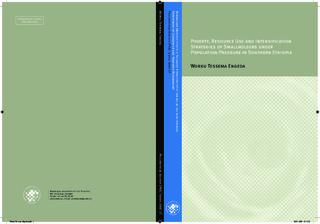| dc.contributor.advisor | Holden, Stein | |
| dc.contributor.advisor | Angelsen, Arild | |
| dc.contributor.author | Engeda, Worku Tessema | |
| dc.date.accessioned | 2017-02-09T14:40:27Z | |
| dc.date.available | 2017-02-09T14:40:27Z | |
| dc.date.issued | 2007 | |
| dc.identifier.isbn | 978-82-575-0795-4 | |
| dc.identifier.issn | 1503-1667 | |
| dc.identifier.uri | http://hdl.handle.net/11250/2430194 | |
| dc.description.abstract | The dissertation investigates resource use and intensification strategies of smallholders facing poverty and population pressure. It comprises an introduction and four independent papers. Based on data collected from a densely populated highland in Southern Ethiopia, paper I analyzes the farm size-land productivity relationship under population pressure.The inverse relationship (IR) at farm household level is partly explained by intensification through expansion of the cultivated area and partly by a yield increase on cultivated area. The plot level analysis suggests that the IR for yield at farm level could be due to omission of observed land quality attributes. Intensification strategies through the use of improved technologies are constrained by financial limitations and asset poverty. Paper II explores the relationship between the intensification of a starchy perennial crop (enset) and asset poverty. Enset is known to be productivity enhancing, land conserving, and a food security crop. A positive and significant synergy exists between productivity of this crop and livestock ownership, facilitating the process of intensification. Livestock- and land-poor farmers had lower land productivity and lower returns to their scarce resources, while livestock-rich but land-poor households had higher land productivity. Paper III assesses households’ harvesting decisions of the perennial and finds that consumption needs of large households and persistent food insecurity problems in the area enhance early harvesting of this crop by the poor, leaving less for the future. Early harvesting for immediate susbsistence requirements reduces future availability and puts the households in a vicious circle of poverty. Paper IV identifies factors affecting conservation investment decisions of the farm households. It concludes that their capacity to invest in soil conservation is constrained by asset poverty and liquidity constraints. Their willingness to invest in labour or cash increases with livestock wealth and non-farm income motivates cash payments. | nb_NO |
| dc.language.iso | eng | nb_NO |
| dc.publisher | Norwegian University of Life Sciences, Ås | nb_NO |
| dc.relation.ispartofseries | PhD Thesis;2007:37 | |
| dc.rights | Attribution-NonCommercial-NoDerivatives 4.0 Internasjonal | * |
| dc.rights.uri | http://creativecommons.org/licenses/by-nc-nd/4.0/deed.no | * |
| dc.title | Poverty, resource use and intensification strategies of smallholders under population pressure in southern Ethiopia | nb_NO |
| dc.type | Doctoral thesis | nb_NO |
| dc.subject.nsi | VDP::Social science: 200::Economics: 210 | nb_NO |
| dc.source.pagenumber | 155 | nb_NO |

